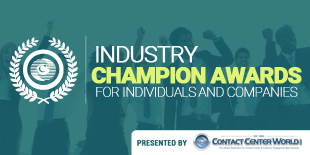NEXTGEN-TV PROGRAMMING
NOW PLAYING
Starting on the hour every hour today
Coming up this Week
| You have one seamless, cross-enterprise customer view. When a customer contacts your business via the call centre, call centre agents can see all relevant customer information – history of previous contacts in person, on the phone, on the Web and via WAP phone, products held, personal data and personal preferences. Every time your customers contact you, no matter how, their information is at the ready, and he or she can complete transactions and make requests in minutes. It's hassle-free. It's personalised. And it's highly effective for up- and cross-selling. Pretty impressive, isn't it? Operating smoothly in this fashion is generally the result of a huge amount of work on the business and IT side, and massive integration investments. You could see your company reaching this stage after completion of a long, hard journey. But as you probably already realise, customers fail to empathise with you. | |
|
Being able to serve customers via new channels such as web, palm tops, and WAP phones has the potential to save a great deal of money. You've heard it all before: there is no human element in many new channels, so low staffing costs; no physical element, so no facility costs; no paper element, so no administrative costs. The outlook for doing business this way is good: E*Trade Securities, which began offering a real-time online account application about one year ago, has said that internet-based systems reduce costs by 75%. That's huge. Also, despite the preponderance of personal productivity tools in use today, such as email, video conferencing, PDAs (personal digital assistants), people are busier and shorter than ever on time. Customers are not interested in waiting in queues, or for you to call them back or for their applications to go through. Allowing them to serve themselves so easily is a key factor in both keeping and attracting customers. E-commerce and m-commerce are rapidly changing the way business is done. Two billion people will be on the internet by 2005, increasing the already huge market opportunity this presents, especially to service-oriented industries such as banking and insurance.
Technology bridges the gap Part of this is the ability to execute targeted marketing and cross selling. The ideal scenario is a closed loop; organisations work faster and more efficiently, while at the same time their software applications are gathering extensive information on customers, products, processes and channels. This information can then be fed back into the system, bolstering product development and marketing campaigns.
Putting tasks en route The key to improved service and efficiency in any organisation is to transfer work to the people qualified to do it. This is becoming more difficult as financial organisations become more complex and the decision is often left to those on the front line, talking to the customer. They have to answer questions like, "Is this product administered by us or a subsidiary? Should the lead be handled in the branch or in the call centre? Where is the nearest branch to the customer in question?" A software system geared for sophisticated workflow involving automatic routing can give these answers instantaneously. Using automatic routing, these everyday decisions are taken by the system, which both reduces the company's workload and provides the consistency needed to run an efficient business. Work can be routed from branches and call centres to product, channel or function-oriented teams. Sales appointments can automatically be scheduled with the qualified person in the nearest branch, or in some cases, a quotation engine can calculate a pre-approved offer and the customer can purchase a product such as a mortgage or a loan online without ever having to speak to anyone. Getting the work to the right place, however, is only the first step in a workflow system at a financial services provider. Having the information ready to perform the task is also essential. The information for each task needs to be predefined, automatically prompting a bank or insurance company's customer-facing people or websites for the appropriate details. This way the financial institution will avoid having to contact the customer later on to ask additional questions, which reduces cost, improves customer service and helps avoid losing business by allowing too much time elapse before the sale is completed.
One day at a time The person who is meeting the customer has requirements as well – where was the lead created? When? Which campaign? This same information also needs to be consolidated and reported on for the organisation as a whole. The good news is, with an effective automated CRM and workflow system, service staff will have much more time for customers that warrant additional personalised, face-to-face attention. With a system that can route tasks, automate routine administration, and even make routine decisions unassisted, staff will be free to spend more time directing their attention where it counts. This promotes more responsibility and ownership on the part of individuals, which has the general knock-on effect of increased employee satisfaction, which will prove to be invaluable. The benefits to customers are impressive, as well: they have an almost perfect world. Their dealings with the financial institution takes up less time, are simpler to complete, are transparent, and they feel they are in direct control by having a choice of channels to use, some of which are unassisted self service. When they do need to meet with someone in the organisation, they receive unparalleled and personalised service. This level of comfort goes a long way in keeping customers from straying to competitors.
The M-word But, rarely do two organisations happen to have identical systems that are simple to integrate. How to handle this? Component-based systems are the future direction for CRM and workflow technology. Building a software system is like building a house; at some point you may want a new door, or a new roof. Your system should be flexible enough to allow this. But systems that are built on proprietary technologies are very difficult to change, as many organisations are finding out. In a house built with proprietary technologies you are stuck with that same door until you knock the entire house down. The flexibility and scalability of component-based software systems enable much faster and more successful integrations of merged companies. With a system built with software components, you can adopt improved pieces of enabling technology quite quickly and with a minimum of investment, and rapidly expand your applications to cover additional user groups and areas of business. The current and future business climate is a kaleidoscope of shifting standards, practices, and structures, and companies are forced to rethink their strategy to survive. Adapting the business on the IT side often looms as a nightmare, but thanks to the industry-savvy solutions providers on the market today and the evolution of flexible software structures, your business can be ready for action in a fraction of the time previously possible. The right technology enables your business and frees up your time, giving you the edge to offer truly superior customer service. About the Author About the Company | |
Published: Friday, January 31, 2003
NEXTGEN-TV PROGRAMMING
NOW PLAYING
Starting on the hour every hour today
Coming up this Week

 |  Bharat Parshotam Bharat ParshotamHead Direct Delivery Absa |
 |  Nathalya Wani Sabu Nathalya Wani SabuExecutive Vice President PT. Bank Central Asia, Tbk |
 |  Aymen Ismail Aymen IsmailHead of Customer Engagement Solutions smart Europe GmbH |
 |  Sindhu Porwal Sindhu PorwalDeputy Vice President ICICI lombard |
 |  Emmanuel Omoike Emmanuel OmoikeTeam leader QPhoto Pty |
 |  Nuryanto - Nuryanto -Head of CSM Operation Bukalapak |
 |  Danny Singer Danny SingerFounder& Chief Product Officer Noetica |
 |  Pooja Raiyani Pooja RaiyaniVice President ICICI Lombard GIC Ltd |
 |  Ben Oxford Ben OxfordHead of Digital Crisis Support Services Lifeline WA |
 |  Bill Quiseng Bill QuisengChief Experience officer Bill Quiseng dot com |
I am checking out all the amazing and daily updated content on ContactCenterWorld.com and networking with professionals worldwide
Send To Friends Post On My Wall